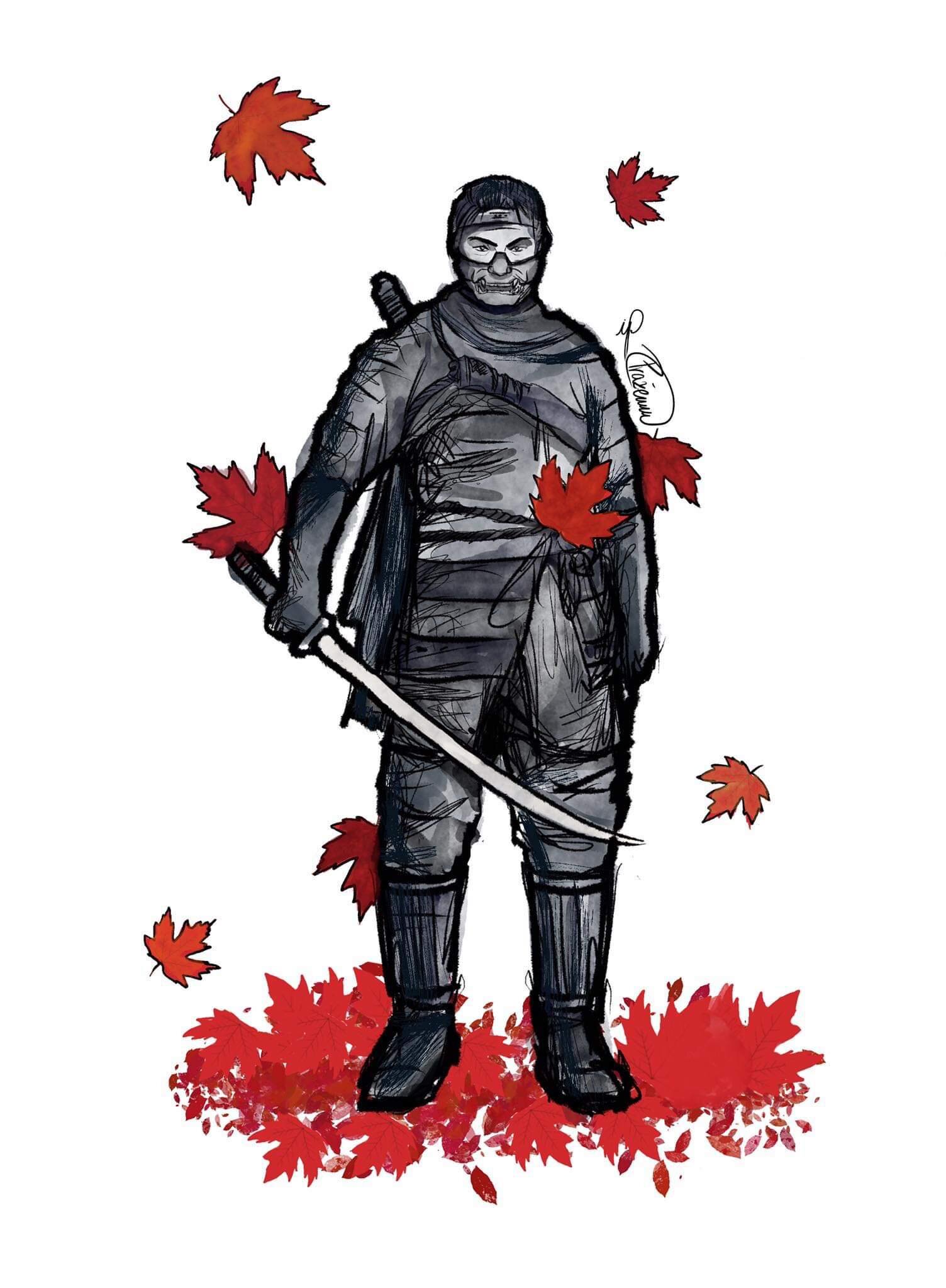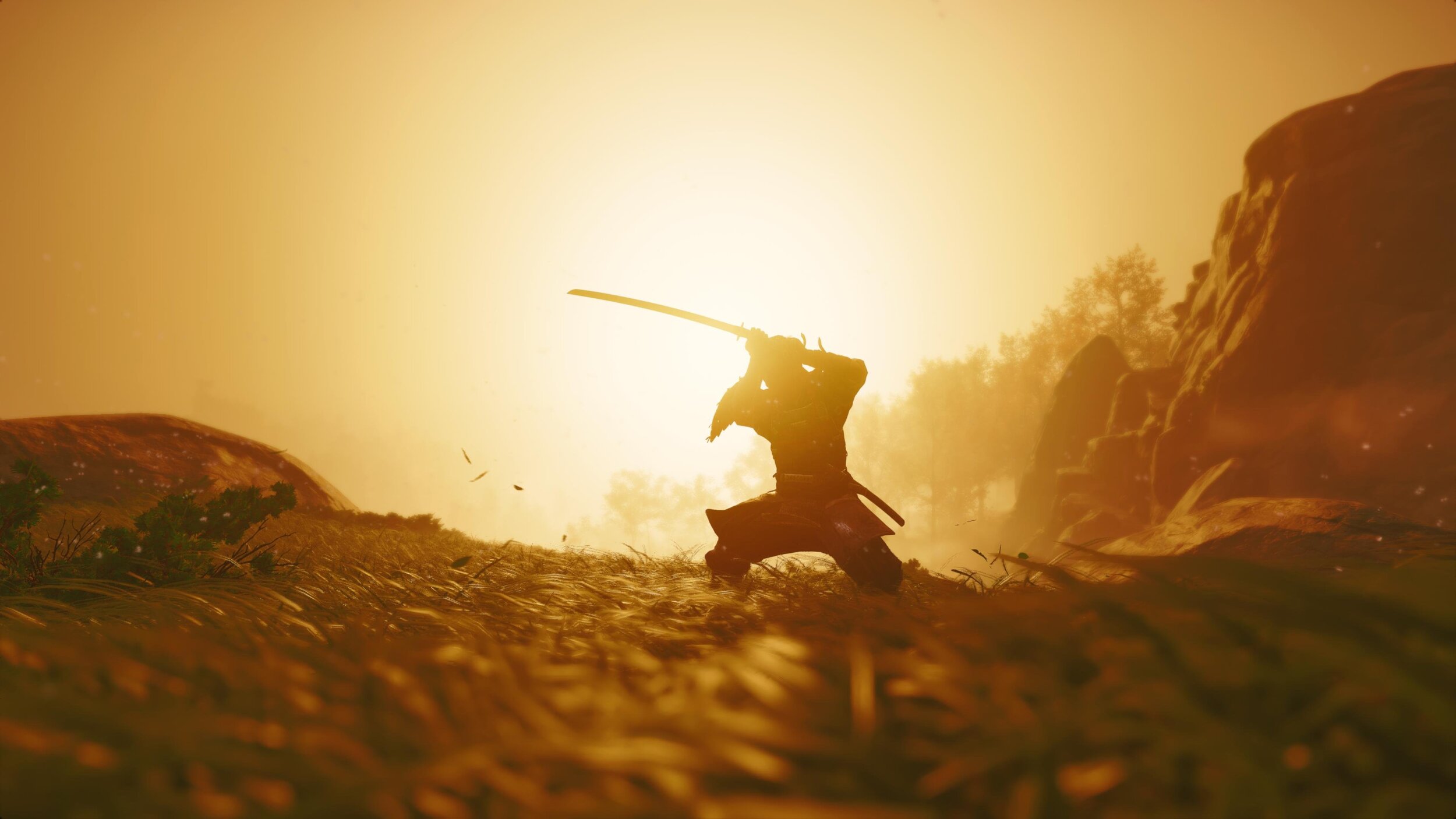Ghost of Tsushima review : If Kurosawa made video games
Artwork by Bibiana Praženková
Max Radó / March 5 2021
(8 min. read)
In single-player video games as in movies, the story and message is the most important part of the work. If we were to take 7 Samurai or Yojimbo and Ghost of Tsushima, a fan of feudal Japan would surely appreciate both. The only difference is that the player is put into the shoes of a samurai and instead of getting a 2-hour long adventure, the player will be living this story for 40 hours.
Tsushima, a small island between mainland Japan and Korea, is unexpectedly invaded by Mongol raiders lead by Khotun Khan (a fictional grandson of Genghis Khan) which aim to subdue all of Japan. You will play as Jin Sakai, a noble samurai who’s determined to drive out the savage invaders and save the island from annihilation. After witnessing the cold murder of his father at a young age, the only family he has left is his uncle Shimura, a local samurai warlord. To Jin, Shimura represents more than a care-taker and a mentor, he thinks of him as a father. The story starts when the samurai mount a defence to crush their enemies. Unfortunately, the Mongols do not fight with honour as the samurai philosophy dictates and all of the samurai apart from Jin are massacred and Shimura is taken as a hostage. This is where the deconstruction of Jin’s former-self begins, for he sees that he needs to abandon the samurai code to save the island and his last living relative. Nevertheless, such a feat cannot be accomplished without allies. Mythical stories, which is a series of side quests, dedicated to each ally of Ghost’s are worth exploring. The headstrong thief Yuna, the unbending archer Ishikawa, the vengeful warrior Masako and the warrior monk Norio all teach Jin necessary conventional or unconventional skills which transform him into the legendary Ghost, all while uncovering their fragile side. In other words, the main and the side characters all experience tragedy and downfall, and all of it is triggered by the invasion of Mongols. Such is the story of Ghost of Tsushima, it is not only samurai fiction, it shows human suffering, betrayal, sacrifice, and above all, survival. While the player has no control over whether Jin becomes Ghost, he has a say in what kind of Ghost will Jin become, meaning that there is a degree of player’s morality which is reflected in his Ghost.
On the technical side, the game is visually stunning in both the landscape and character design. In-game Tsushima has a lot to offer there is everything from snowy mountain peaks, steep oceanside cliffs with small shrines, bamboo forests to beaches full of seagulls and all of it can be found on a smaller map in comparison with other major story-driven open-world games. However, the density and the quality of activities within the map far outweigh the scale of the map. While some activities are merely collecting loot such as cosmetic skins or charms, the player can also assemble his haikus (even though they didn’t exist in this period). Moreover, I enjoyed the minimalist touch in HUD design. Any unnecessary and flashy HUD would hinder the enjoyment and I’m really glad the developers have decided to not have any of it. Even though there are bigger maps in modern open-world video games, the density of activities within Tsushima is far more satisfying than having an enormous, yet somewhat space.
The gameplay is well-designed, polished and smooth, the combination of age-old light and heavy attacks is familiar ground for many, yet Sucker Punch included a feature called Combat Stances, which breathes new life into this combat system. The stances are designed to help the player defeat different kinds of opponents, for example, the Stone stance is most effective against swordsman while the Water stance is suited to fight NPC’s carrying a shield. Since the player can change the stance mid-combat, this makes combat fun and each encounter will be different from the previous one. Stealth, on the other hand, is somewhat lacklustre. It resembles the old Assassin’s Creed games where assassinations are easy to execute and even if you are spotted and flee, enemy NPCs react only for a brief amount of time before they go back to their pre-programmed paths. Ghost also has 2 bow variants at his disposal, short for stealth and long for damage. In addition to the bows, the protagonist also uses gadgets that suit either stealth or head-on approach. However, the best innovation in combat is the standoff mechanic. It's a brilliant mechanic that not only works with the samurai motif but also makes the disadvantageous tactic of walking right into an enemy outpost through the front gates even more so enjoyable. If executed well the standoff mechanic is more satisfying and rewarding than using stealth. The standoff makes the game look closer to the epic duels in the iconic samurai films.
The arguably most prominent feature of the game is the Kurosawa mode. In this mode, the game will resemble movies of Kurosawa both in the image and in sound. When turned on, the image would be strictly black and white and a film grain effect, while the sound would increase the sound of wind and rain and added some cracking noise. This feature can be turn on and off anytime the player desires. Even though it is a fantastic and original feature, I do not recommend playing the whole game with the filter on. I used this mode only occasionally, for a quest or dialogue-heavy cutscenes but rarely during free roam, as I believe the game world is much more enjoyable with colour and the game’s beautiful soundtrack.
However, the game has to be taken with a pinch of salt, for the game was inspired by samurai films, which idealised samurai as ancient heroes, more than historical records of 13th century feudal Japan. Moreover, I do believe that Ghost of Tsushima is more of a superficial version of the work of Kurosawa and his peers since the game takes only the form of these movies, the popular aesthetics, but it does not convey the message which these films sent out. The criticism of the romanticised samurai warriors who’s blind loyalty towards a code made them act in utter violence or their selfishness which makes them act only for the sake of their profit is absent in the game.
This game is exactly what the fans of the Assassin’s Creed franchise wanted for so many years, and more, since this game does not only fiddle with stealth but with some movie-like samurai head-to-head action as well. Ghost of Tsushima is the best game Ubisoft never made, and it is good that the game was made by Sucker Punch, for if it was made by Ubisoft, I would not dare say it would turn out as well as it did. The game is superbly entertaining whether by its storytelling or by its visuals. If the player realises that he is playing a game based on movies rather than history and takes its inaccuracies in mind, Ghost of Tsushima is an interactive film from the 1950s. One can only wonder what would master Kurosawa think of this game, whether he would praise it or be enraged by it.











